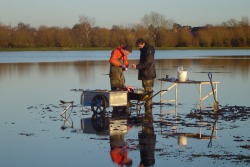Abandoned landfills are a big problem

Abandoned landfill sites throughout the UK routinely leach polluting
chemicals into rivers, say scientists.
At Port Meadow alone, on the outskirts of Oxford, they estimate 27.5
tonnes of ammonium a year find their way from landfill into the River
Thames. The researchers say it could be happening at thousands of sites
around the UK.
In water, ammonium breaks down into nitrogen. The extra nitrogen can trigger excessive plant growth and decay, damaging water quality and starving fish and other aquatic organisms of the oxygen they need to survive.
Scientists are most worried about so-called blue-green algal blooms, which can produce toxins capable of killing wild animals, livestock and domestic pets. In people, they can cause skin rashes, nausea, stomach pains, headaches and fever.
'We've been getting rid of waste for an awful long time,' explains Dr Daren Gooddy, of NERC's British Geological Survey, who led the study. 'Since Victorian times, we've been putting it into landfill and ad-hoc waste dumps on the edge of our towns and cities, often on the fringes of floodplains.'
'There are 11 landfill sites at Port Meadow alone. If you scale that
up for the whole of the UK, then you're probably talking about thousands
of them.'
Port Meadow lies on the banks of the River Thames to the northwest of
Oxford. The area is popular with walkers and birdwatchers, with annual
winter floods attracting spectacular flocks of wildfowl and waders.

Sampling at Port Meadow
The birds make their own contribution of ammonium to the floodplain,
effectively using the wetland as an enormous open-air toilet.
To disentangle the different sources of the chemical, and get an
estimate of the total amount moving through the floodplain, the team
drilled a series of boreholes, taking regular water samples for three
years between May 2010 and August 2013.
Using isotopic analysis, a kind of chemical fingerprinting technique,
they were able to attribute 27.5 tonnes of ammonium to household waste.
Over an eight kilometre reach of the Thames at Port Meadow, this could
increase concentrations of the chemical by up to 40 per cent.
Nutrient pollution of waterways has been a growing concern over recent
decades. Fertilisers containing large amounts of nitrate and phosphate
are used on farmland up and down the country to boost crop growth.
Much of this eventually finds its way into rivers, where it can wreak
havoc on ecosystems, and raise the cost of treating water for human
consumption.
Today's landfills are lined with a thick layer of clay to limit the risk
of chemicals leaking out into the environment. But around the UK, there
are potentially thousands of un-lined historic landfills leaching large
amounts of nitrogen into major rivers.
Gooddy says it's a scenario likely to be repeated throughout the
developed world.
'Collectively, this contribution to overall ammonium concentrations in
rivers could be very high,' he says. 'It's something that really ought
to be taken into account when we're drawing up management plans for
floodplains on the margins of towns and cities.'
The research is published in the journal Science of the Total
Environment.
Dump image via Shutterstock.